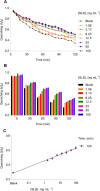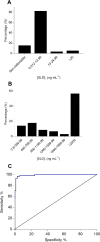Nanophotonic Sialidase Immunoassay for Bacterial Vaginosis Diagnosis
- PMID: 33615186
- PMCID: PMC7887842
- DOI: 10.1021/acsptsci.0c00211
Nanophotonic Sialidase Immunoassay for Bacterial Vaginosis Diagnosis
Abstract
Bacterial vaginosis (BV) affects reproductive-age women and can lead to pelvic inflammatory disease, postpartum endometritis, and preterm labor/delivery and predisposes the infection of sexually transmitted diseases. Typically, BV diagnosis involves the analysis of vaginal swab samples via microscopy operated by highly skilled personnel. Hence, novel approaches for BV diagnosis are an existing need. In response, the first immunosensing platform targeting sialidase, a BV biomarker, is reported. The nanophotonic operational principle of this biosensing platform allows for a cheaper, faster, and simpler analysis when compared with an indirect enzyme-linked immunosorbent assay (ELISA). The clinical evaluation of such a nanotechnology is highlighted, where 162 vaginal swab samples were analyzed with high sensitivity and specificity (96.29%, respectively). The resulting nanoimmunosensing platform offers a resourceful approach to perform a timely BV diagnosis.
© 2021 American Chemical Society.
Conflict of interest statement
The authors declare the following competing financial interest(s): Pending patent. Mexico patent application: MX/A/2019/010242.
Figures



Similar articles
-
Disposable Device for Bacterial Vaginosis Detection.ACS Meas Sci Au. 2023 Jun 17;3(5):355-360. doi: 10.1021/acsmeasuresciau.3c00007. eCollection 2023 Oct 18. ACS Meas Sci Au. 2023. PMID: 37868361 Free PMC article.
-
[Bacterial vaginosis. Epidemiology and risk factors].Srp Arh Celok Lek. 2000 Jan-Feb;128(1-2):29-33. Srp Arh Celok Lek. 2000. PMID: 10916461 Serbian.
-
Novel bacterial vaginosis-associated organisms mediate the relationship between vaginal douching and pelvic inflammatory disease.Sex Transm Infect. 2020 Sep;96(6):439-444. doi: 10.1136/sextrans-2019-054191. Epub 2019 Dec 6. Sex Transm Infect. 2020. PMID: 31810995 Free PMC article.
-
Bacterial vaginosis. Transmission, role in genital tract infection and pregnancy outcome: an enigma.APMIS. 2005 Apr;113(4):233-45. doi: 10.1111/j.1600-0463.2005.apm_01.x. APMIS. 2005. PMID: 15865604 Review.
-
Bacterial vaginosis.Clin Microbiol Rev. 1991 Oct;4(4):485-502. doi: 10.1128/CMR.4.4.485. Clin Microbiol Rev. 1991. PMID: 1747864 Free PMC article. Review.
Cited by
-
Bacterial Vaginosis: What Do We Currently Know?Front Cell Infect Microbiol. 2022 Jan 18;11:672429. doi: 10.3389/fcimb.2021.672429. eCollection 2021. Front Cell Infect Microbiol. 2022. PMID: 35118003 Free PMC article. Review.
-
Disposable Device for Bacterial Vaginosis Detection.ACS Meas Sci Au. 2023 Jun 17;3(5):355-360. doi: 10.1021/acsmeasuresciau.3c00007. eCollection 2023 Oct 18. ACS Meas Sci Au. 2023. PMID: 37868361 Free PMC article.
-
Gardnerella Revisited: Species Heterogeneity, Virulence Factors, Mucosal Immune Responses, and Contributions to Bacterial Vaginosis.Infect Immun. 2023 May 16;91(5):e0039022. doi: 10.1128/iai.00390-22. Epub 2023 Apr 18. Infect Immun. 2023. PMID: 37071014 Free PMC article. Review.
-
AI-Assisted Real-Time Immunoassay Improves Clinical Sensitivity and Specificity.Anal Chem. 2024 Jul 9;96(34):13756-61. doi: 10.1021/acs.analchem.4c00764. Online ahead of print. Anal Chem. 2024. PMID: 38980814 Free PMC article.
-
BVBlue as a diagnostic instrument for the diagnosis of bacterial vaginosis: a systematic review.BMC Womens Health. 2025 Feb 28;25(1):90. doi: 10.1186/s12905-025-03615-4. BMC Womens Health. 2025. PMID: 40022063 Free PMC article.
References
-
- Kerubo E. N.; Laserson K. F.; Otecko N.; Odhiambo C.; Mason L.; Nyothach E.; Oruko K. O.; Bauman A.; Vulule J.; Zeh C.; Phillips-Howard P. A. (2016) Prevalence of Reproductive Tract Infections and the Predictive Value of Girls’ Symptom-Based Reporting: Findings from a Cross-Sectional Survey in Rural Western Kenya. Sex Transm Infect 92 (4), 251–256. 10.1136/sextrans-2015-052371. - DOI - PMC - PubMed
-
- Kulshrestha S.; Soni P.; Parihar R. S.; Khatri P. K.; Chandora A K..; Soni L. K. (2015) Abnormal vaginal discharge: comparison of clinical and microbiological criteria for the diagnosis of bacterial vaginosis in western rajasthan, india. Int. J. Biol. Med. Res. 6, 5090–5094.
-
- Bautista C. T.; Wurapa E.; Sateren W. B.; Morris S.; Hollingsworth B.; Sanchez J. L. (2016) Bacterial Vaginosis: A Synthesis of the Literature on Etiology, Prevalence, Risk Factors, and Relationship with Chlamydia and Gonorrhea Infections. Mil Med. Res. 3, 4.10.1186/s40779-016-0074-5. - DOI - PMC - PubMed
LinkOut - more resources
Full Text Sources
Other Literature Sources
